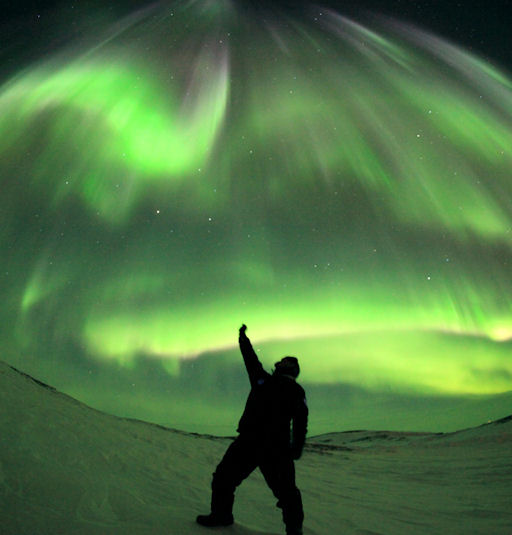FARSIDE CME: A spectacular CME rocketed away from the sun's northwestern limb during the early hours of March 18th: movie. The probable source was old sunspot AR1429, still active as it transits the far side of the sun. Earth will not be affected by the cloud.
NORTHERN LIGHTS: For the third day in a row, a high-speed solar wind stream is buffeting Earth's magnetic field. The jostling is not enough to cause a full-fledged geomagnetic storm, but some nice intermittent auroras are flickering around the Arctic Circle. In the northern village of Ivujivik, Quebec, Sylvain Serre photographed an outburst on March 18th:
"What an incredible night," says Serre. "The Northern Lights weren't there when I first went outside, but after 5 minutes they were so strong that I had to try new settings for my camera."
NOAA forecasters estimate a 30% chance of geomagnetic activity during the next 24 hours. High-latittude sky watchers should remain alert for auroras as the solar wind continues to blow. Aurora alerts: text, phone.
more images: from Jónína Óskarsdóttir of Faskrudsfjordur, Iceland; from Peter Scott of Durness, Scotland, UK; from Francis Anderson of Tuktoyaktuk, Northwest Territories Canada; from Chad Blakley of Abisko National Park, Sweden; from Iurie Belegurschi of Iceland; from Dirk Obudzinski of Cleary Summit, Alaska; from Petra Schneider of Reykjanes peninsula, Iceland; from Greg Kretovic of AuTrain, Michigan

![]()
Solar wind
speed: 524.9 km/sec
density: 0.8 protons/cm3
explanation | more data
Updated: Today at 1636 UT
![]()
X-ray Solar Flares
6-hr max: C1 1351 UT Mar19
24-hr: C1 1351 UT Mar19
explanation | more data
Updated: Today at: 1600 UT
![]()
![]()
![]()
Daily Sun: 19 Mar 12
![]()
![]()
All of these sunspots are quiet. No strong flares are in the offing. Credit: SDO/HMI
![]()
![]()
![]()
Sunspot number: 54
What is the sunspot number?
Updated 18 Mar 2012
Spotless Days
Current Stretch: 0 days
2012 total: 0 days (0%)
2011 total: 2 days (<1%)
2010 total: 51 days (14%)
2009 total: 260 days (71%)
Since 2004: 821 days
Typical Solar Min: 486 days
Updated 18 Mar 2012
The Radio Sun
10.7 cm flux: 102 sfu
explanation | more data
Updated 18 Mar 2012
![]()
![]()
![]()
Current Auroral Oval:
![]()
Switch to: Europe, USA, New Zealand, Antarctica
Credit: NOAA/POES
![]()
![]()
![]()
Planetary K-index
Now: Kp= 2 quiet
24-hr max: Kp= 4 unsettled
explanation | more data
![]()
Interplanetary Mag. Field
Btotal: 3.0 nT
Bz: 0.7 nT south
explanation | more data
Updated: Today at 1636 UT
![]()
![]()
![]()
Coronal Holes: 19 Mar 12
![]()
![]()
There are no large coronal holes on the Earthside of the sun. Credit: SDO/AIA.





